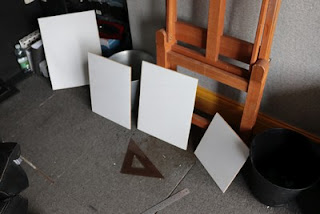A delivery of art to Bickerton yesterday, and a walk up the hills with beloved Deborah. Something of a rest day.
I hate rest days, but I'm increasingly wanting to rest. An artist must be working, charging forward, but I'm increasingly feeling exhausted, overworked and unrewarded. Do we deserve rewards from nature by performing our natural duty? I thought today that had Vincent van Gogh managed to continue working and living for another decade or two, that he would not have become as famous and renowned as he did. He may well, in art history, have ranked alongside Gauguin and Cezanne, but not have gone beyond those to attain his great fame. He may even have slipped into academic obscurity. His suicide was a crucial part of his art.
I updated my website yesterday, slight updates to the biographical notes in the painting galleries. This is a useful observation of the past, a reflection. I thought about what has changed in my outlook regarding art since my book 21st Century Surrealism. One aspect is a greater distance from surrealism, a label I've usually disliked but grudgingly become accustomed to as a short-cut explanation of the 'type of painting' I make. Perhaps I should stop using it entirely. Perhaps this label is not helpful because artists should be doing what is new, and I think I am and do. Another change is that the intellectual content of an artwork, the quantity of 'information', is less important to me now. Now, I want to create an overall feeling that can't be put into words.
I watched a sad BBC documentary about Picasso, sad because it was a poor and cheap programme from a broadcaster who used to be a paragon of British, if not western, culture. The BBCs best programmes are now on the radio.
The documentary made me think about cubism. There are many strange aspects about it. Firstly, that rather than represent an object or scene from multiple angles, cubist paintings often break up the scene into literal cubes, geometric shapes, harsh lines. The cubist offshoots, Orphism, Purism and the evolution into geometric abstraction continued that path, bypassing realism, detail, accurate depiction. Picasso himself avoided pure abstraction as 'decorative'; I agree, with the caveat that we can appreciate abstract art by seeing things in it - communications about the artist (abstract expressionism) or the world, by seeing things in the shapes (abstract... imagerism? pareidolia?).
In cubism, accurate depiction of a thing became increasingly ignored. Colours became brighter, surfaces flatter. In real life surfaces are not flat, and colours are realistic. Ultimately, cubism gradually became decorative, rather than representational. Picasso's unique mature style still represented things, but a lot of reality was removed. Crucially, I saw yesterday a new world of art that has not been touched, a whole branch of cubism which was bypassed and not explored.
Taking as a principle that a single perspective and viewpoint should be ignored, it seems quite possible to represent a scene without great abstraction of form or colour. Colours could always remain realistic, even shading. Shading and depicting depth in an image was quickly (if not instantly) removed from cubism, perhaps because the aim was to remove depth illusion, when it seems quite reasonable to include depth, and even perspective; merely not one. When we look at a painting, the very illusion of depth is attractive - it makes us believe in an image. The illusory impression of depth is appealing in a unique way.
So the lost cubism involves shading and the illusion of depth. It involves surface detail - another thing which was removed from cubist paintings without explanation. It also involves realistic colours, or at least colours which are not artificially gaudy or deliberately pretty. Yet it still represents a scene from multiple views at once, like a mental image of knowledge.
This, oddly, made me think of my Symphonic Paintings, and the Ekphrastic ones which played on a theme, like the Andy N paintings, like 'Twice As Hard' here, inspired by Caravaggio:
Here, Caravaggio's 2D image was the source, but it's still broken into parts, and retains the original shading and colouration; those things were not abstracted or enhanced.
I have a book '1001 Paintings You Must See Before You Die'. It's wonderful in that it is ordered chronologically, and therefore offers an overview of all art. Until about 1800, paintings were as functional as passport photos, posters, propaganda. All of that art is irrelevant today except as cultural memory. 'Modern' art from 1850 to 1950 was experimental, but somewhat tedious, self questioning. Looking thorough the book, art only seemed to be interesting after about 1960.
I'm amazed by anyone who thinks that, in art, 'it has all be done'. The more I know, the more I can see how much I don't know, that my ignorance is vast. Blessed be my ignorance, for there lies the undiscovered country, the place of magic. Despite this I can see huge plains of types of art that are totally unexplored. Among them:
The Symphonic Painting which used visual themes, like Beethoven used musical themes. Monochrome painting which makes equal use of negative spaces; M.C. Escher and a few printers explore this sort of thing, very few painters. The form of realism-cubism explored here. So many hybrids! Abstraction fragmented with realism. Impressionism fragmented with realism. Social realism fragmented with fantasy...
There are so many virgin genres, new worlds in painting. The more you think you know, the more blind you become to the unknown. The role of the artist is to explore the unknown, in private and in public. One difference between art and science is that art does not necessarily have to, or perhaps even should not, conclude anything. Such conclusions are for observers, critics, aesthetes; the scientists of art.









































